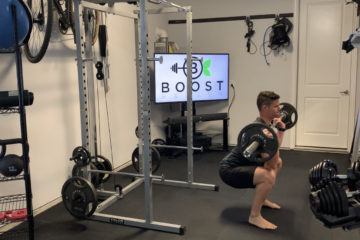
I love listening to music when I exercise if I am by myself. I also really enjoy chatting with a buddy when riding a bike or going on a run. I am not a fan, however, of exercising in silence. I have mentioned previously that inside my brain is a scary, panicky, and anxiety-laden mess that requires various tricks of the mental health trade to keep it at bay. I talked about 3 tactics to build mental strength in a previous episode of the BOOST Health Podcast and Blog.
I have been using my new mental strength tactics with good success but I also continue listening to music while exercising as I feel it helps further assist in keeping my mind out of a negative place. I also just really enjoy getting in a rhythm with music on a run or bike ride. There is something very satisfying about finding a song that matches your running or cycling cadence. I love hearing the bass and snare drums hitting just as my foot meets the ground or pushes a pedal. Running is especially important for me to have good music. Maybe it is because it hurts a lot and I want to take my mind off the pain. If I have a good song in my ear it can make a huge difference in how I feel and perform.
I was thinking about how important my music is for happiness and performance when my headphones lost their charge recently. It was almost devastating! Ok I admit, I was full on devastated. I always listen to music when strength training and when running and cycling alone. I keep it at low volume so it is not dangerous as I can easily hear cars or even people talking as I pass by them. From a cycling perspective, some purists would say this goes against “the rules” including #61 by Velominati.
For years race directors, most likely from an insurance perspective, have been outlawing music and headphones. In 2006 the USA Track and Field organization banned use of headphones in their sanctioned events. This is just for running events! In 2008 they amended the rule to only include “those competing in Championships for awards, medals, or prize money”. Again this probably has more to do with insurance than actual safety risk. Just a couple weeks ago a buddy of mine got disqualified from a duathlon (run, bike, run) race for wearing headphones. He was kindly notified after he completed the race…ouch! We could argue about whether or not it is a safety risk based on numerous variables. Pushing safety concerns aside, what about claims that music can be a performance enhancer? Can music actually help us perform better in sport and in life in general? The answer is resoundingly yes! I am about to share 7 Ways music enhances your performance and health.
1. Music Increases Exercise Performance
A 2012 study in the International Review of Sport and Exercise Psychology by Karageorghis and Priest, included a major review and synthesis of music and effects on exercise. They found that music can be used successfully before exercise as a motivational tool to get started. They also saw some trends in listening to music during the exercise task including reduction in perception of effort by about 10% in low to moderate exercise intensities. Music also apparently enhances exercise performance this is most likely is due to the reduced perception of effort. Finally they found that the tempo of the music can play a role in how it assists the exerciser where fast music increases physiological arousal and is preferred when running at fast speeds.
2. Music Improves Productivity
This intuitively makes sense. If you are listening to music that improves your mood you are going to be happier and more engaged in your work, and thus be more aware and productive in your work. You may want to consider listening to music without lyrics though. According to a 2008 study by The Finnish Institute of Occupational Health, speech in the office space is the most distracting source of noise.
Perhaps this is why productivity gurus including Tim Ferris and WordPress Founder Matt Mullenweg listen to songs on repeat to get into a groove. If the songs have lyrics they will be able to eventually tune them out after hearing the song so many times. Joseph Mosby discusses the science behind productivity and listening to songs on repeat on his site and how it can help you “dissolve” into the music. This makes sense as can help your mind eliminate outside distractions and have intense focus. This is tremendously important when to trying to do creative work and big projects.
I personally prefer music without lyrics to use for concentration and productivity and also a bit of variety versus listening to songs on repeat. Classical music and chill/trance electronic music work great for me. Below are a few of my favorites.
- Electronic Music for Studying Concentration | Chill Out Electronic Study Music Instrumental Mix
- Classical Music for Brain Power – Mozart Effect
- Electronic Music for Studying, Concentration and Focus | Chill House Electronic Study Music Mix
3. Music Increases Endurance
A 2018 study that was presented at the American College of Cardiology Scientific Session by Dr. Waseem Shami and team, found that listening to upbeat music increased the endurance of participants during a treadmill running test. For the study there were 127 participants that were split into 2 groups where 1 group wore headphones but listened to no music and the other group wore headphones and listened to upbeat Latin music. The study found that the group listening to music was able to last an average of 50 seconds longer than the non-music group. This could have a big impact especially if doing a high intensity interval workout where you would be able to potentially hold a set for longer or more intensity.
4. Music Decreases Stress
A 2006 study in the Annals of The New York Academy of Sciences by Khalfa et al, found that relaxing music decreased stress. The study would have the participants complete a psychologically stressful task and then measure cortisol levels after the task was complete. While the cortisol levels were measured the participant would either listen to relaxing music or sit in silence. The results showed that cortisol levels would stop increasing after listening to relaxing music but would continue on for 30 minutes if the participant sat in silence! It wasn’t stated in the study what the relaxing music was, but this would be subjective to the listener anyway.
5. Music Improves Vascular Health
According to a 2008 study in Circulation by Miller et al, self-selected joyful music can improve vascular health by increasing blood flow. Alternatively self-selected anxiety generating music has the opposite effect as it decreases blood flow. The study measured participants’ blood flow by evaluating brachial artery flow mediated dilation when they listened to various music. Again it isn’t clear which music they used but it is assumed, since it was self-selected, that it was music that personally created joy which increased blood flow. It is amazing that just listening to a song can increase or decrease blood flow!
6. Music Makes You More Efficient
A 2012 study in The Journal of Sports Medicine and Physical Fitness by Bacon et al, found that cyclists who pedaled in tempo with music used 7% less oxygen than when they did the exact same amount of work with just general background music! This would make us assume that the athlete is more efficient when the music helps them keep a steady rhythm.
I used to teach indoor cycling classes and I spent a lot of time planning the playlist for the ride because it would direct the actual workout itself. I also really enjoyed having a fun and fresh playlist and so did my students. My personal style was to use up tempo driving beats from electronic or rock music for speed work and slower hip hop songs for climbs and big gear stuff. We would stay right in tempo with the music which made the classes a lot of fun but also likely made it much easier to perform well based on this study.
7. Music Provides Motivation
In a 2017 study by SOCAN, where 1,500 participants were surveyed, they found that music is as much a necessity as proper workout clothes or fitness equipment for people. I can relate. I mentioned previously the amount of devastation I felt when I lost the charge in my headphones during a workout! I also find I am even more motivated to exercise when I have created a fresh new playlist. I would say it is a similar feeling to when you have a new piece of gear for sport or exercise where you are super excited to try it out.
Example Songs for Threshold and Zone 2 Exercise
Now that we know how music enhances our health and performance I wanted to share some examples of songs I use for threshold and zone 2 exercising.
Def Leopard’s song “Animal” is one of my favorite running songs (yes I am old).
I have always enjoyed this song so it certainly brings up positive memories for me and it also has a nice beat for my running speed at threshold pace. If you are wondering what I mean by threshold pace, I cover running at different heart rate zones in my blog and podcast on the 5 Tactics for the Best Overall Fitness Program.
I was curious what the beats per minute (BPM) of “Animal” was so I looked it up. According to bpmdatabase.com this is a 120 BPM song.
This got me curious about if my other favorite threshold running songs were around the same speed. Just looking at the Def Leopard catalog a couple of my other favorites including “Photograph” and “Armageddon It” are at 123 and 120 BPM respectively. I was intrigued. Was it this particular tempo or did I just love those particular songs to run to? So I looked up a few of my other favorite threshold run songs.
- Metallica “For Whom The Bell Tolls” is 117 BPM
- Metallica “Wherever I May Roam” is 130 BPM
- Megadeth “Countdown to Extinction” is 128 BPM
- Daft Punk “Around the World” is 121 BPM
It seems as though I feel a good match between my cadence on a threshold run and songs that I enjoy that are approximately 120-130 BPM. But what about my slow zone 2 runs? I ran through my playlist for my slower chill runs and came across a consistent BPM of about 100. Here are a few examples:
- Thievery Corporation “Sound the Alarm” 98 BPM
- Kid Cudi “Alive” 102 BPM
- Thievery Corporation “The Forgotten People” 98 BPM
- Fabolous “Baby Don’t Go” 100 BPM
Final Thoughts
If you don’t already use music for relaxing, increasing productivity, or exercising, give it a shot! If you are concerned about safety while training outdoors you could consider leaving one headphone out to make sure you can hear clearly. I like to use a pair of MP3 headphones by Pyle. You can check them out on Amazon below. They are waterproof so you can use them for swimming as well as your other exercise feats, and it is easy to load songs based on the workout or workouts. They can easily be taken off and worn around the neck on a bike ride if you want to chat with buddies. I also like that they are wireless, but not Bluetooth, so you don’t have that signal blasting your noggin on all your workouts. So go ahead and load in your favorite beats and enjoy the increased performance!
Podcast: Play in new window | Download
Subscribe Apple Podcasts | Google Podcasts | RSS



